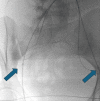Huge Fibroid in Pregnancy: A Case Presentation
- PMID: 38707757
- PMCID: PMC11066712
- DOI: 10.7759/cureus.59566
Huge Fibroid in Pregnancy: A Case Presentation
Abstract
Uterine fibroid, widely known as leiomyoma, is one of the most common benign tumours of the female reproductive system. It is not uncommon for pregnancies to be complicated by uterine fibroids. Most commonly, the first line of large uterine fibroids management in pregnancy is conservative, with myomectomy counselling after delivery if necessary. In this paper, we present a case of a very high-risk pregnancy, that was managed by delivery via caesarean section at 34 weeks of gestation, which was performed for a patient, with an 18 centimetres (cm) fibroid, first diagnosed during pregnancy. Interventional radiology involvement was critical in this case for minimizing the final blood loss and surgical complications. Bilateral internal iliac artery balloons were used. Maternal and foetal risks, the timing of delivery, and the options for the management of fibroids in pregnancy will be discussed.
Keywords: antenatal scan; caesarean section; gestation age; huge fibroid; radiology interventional; uterine fibroid in pregnancy.
Copyright © 2024, Petroulakis et al.
Conflict of interest statement
The authors have declared that no competing interests exist.
Figures
Similar articles
-
The management of uterine fibroids in women with otherwise unexplained infertility.J Obstet Gynaecol Can. 2015 Mar;37(3):277-285. doi: 10.1016/S1701-2163(15)30318-2. J Obstet Gynaecol Can. 2015. PMID: 26001875
-
The management of uterine leiomyomas.J Obstet Gynaecol Can. 2015 Feb;37(2):157-178. doi: 10.1016/S1701-2163(15)30338-8. J Obstet Gynaecol Can. 2015. PMID: 25767949
-
Large Uterine Fibroids in Pregnancy with Successful Caesarean Myomectomy.Case Rep Obstet Gynecol. 2020 Nov 10;2020:8880296. doi: 10.1155/2020/8880296. eCollection 2020. Case Rep Obstet Gynecol. 2020. PMID: 33224543 Free PMC article.
-
Pregnancy outcomes following treatment for fibroids: uterine fibroid embolization versus laparoscopic myomectomy.Curr Opin Obstet Gynecol. 2006 Aug;18(4):402-6. doi: 10.1097/01.gco.0000233934.13684.cb. Curr Opin Obstet Gynecol. 2006. PMID: 16794420 Review.
-
Surgical treatment of fibroids for subfertility.Cochrane Database Syst Rev. 2020 Jan 29;1(1):CD003857. doi: 10.1002/14651858.CD003857.pub4. Cochrane Database Syst Rev. 2020. PMID: 31995657 Free PMC article.
Cited by
-
Innovative Management of a Giant Fibroid in Pregnancy: A Case Report.Cureus. 2024 Oct 5;16(10):e70894. doi: 10.7759/cureus.70894. eCollection 2024 Oct. Cureus. 2024. PMID: 39497893 Free PMC article.
References
-
- Epidemiology and risk factors of uterine fibroids. Pavone D, Clemenza S, Sorbi F, Fambrini M, Petraglia F. Best Pract Res Clin Obstet Gynaecol. 2018;46:3–11. - PubMed
-
- The value of MRI in management of uterine fibroids in pregnancy. Cerdeira AS, Tome M, Lim L. Eur J Obstet Gynecol Reprod Biol. 2021;256:522–523. - PubMed
-
- Obstetric outcomes in women with sonographically identified uterine leiomyomata. Qidwai GI, Caughey AB, Jacoby AF. Obstet Gynecol. 2006;107:376–382. - PubMed
Publication types
LinkOut - more resources
Full Text Sources




